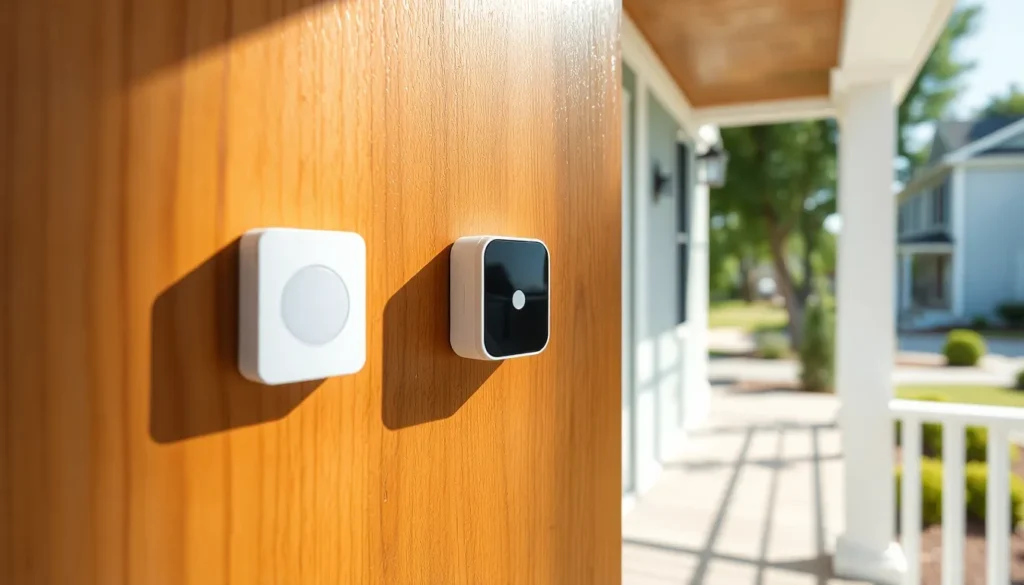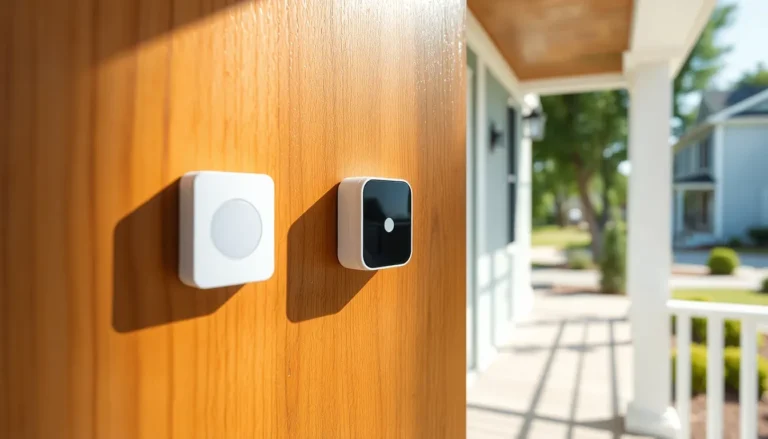Table of Contents
ToggleImagine this: you’re lounging on your couch, enjoying a well-deserved break, when suddenly you hear a noise at the door. Is it the mailman? A surprise visitor? Or just your cat plotting world domination? Enter the wireless door sensor—your trusty sidekick in the quest for home security and peace of mind.
These nifty gadgets not only alert you when someone enters or exits but also add a sprinkle of modern magic to your home. With easy installation and smart technology, they’ll have you feeling like a secret agent in your own living room. Say goodbye to unwanted surprises and hello to the future of home monitoring. Whether you’re a tech whiz or just someone who wants to keep their home safe, a wireless door sensor is the perfect addition to your smart home arsenal.
Overview of Wireless Door Sensors
Wireless door sensors play a crucial role in home security systems. These devices detect when a door opens or closes, sending alerts directly to smartphones or home security panels. Homeowners appreciate the immediate notifications, as they provide real-time updates on entry points around the home.
Installation presents a straightforward process. Many wireless door sensors come with adhesive backing, allowing for quick attachment to doors without the need for tools. Battery life is also significant, with most models lasting several months before requiring replacement.
Integration with smart home systems enhances functionality. Wireless door sensors can connect with other smart devices, such as cameras and alarms, creating a comprehensive security network. Users can also set conditions, such as triggering lights when a door opens.
Various options are available to suit different needs. Some sensors offer additional features like temperature monitoring or two-way communication. Choosing the right model depends on individual preferences and specific security requirements.
Cost considerations vary across models. Budget-friendly options exist, but higher-priced models may offer advanced features and improved durability. Investing in quality sensors often leads to better long-term performance.
Overall, wireless door sensors contribute significantly to enhanced home security. Their ease of use, versatility, and integration capabilities make them essential tools for modern homeowners.
Benefits of Wireless Door Sensors

Wireless door sensors provide notable advantages, enhancing home security and user convenience.
Increased Security
Increased security stands as one of the primary benefits of wireless door sensors. These devices alert users to unauthorized access, ensuring immediate awareness of potential threats. Many sensors include real-time notifications, enabling quick responses to breaches. Models with advanced features often integrate surveillance cameras and alarms, forming a robust security network. A study by the Security Industry Association indicates that homes equipped with door sensors experience up to a 300% increase in deterrence against burglaries. Consequently, homeowners feel more secure knowing that these sensors actively monitor entry points.
Convenience and Automation
Convenience and automation enhance the appeal of wireless door sensors. Many products feature simple installation processes, allowing users to set them up without professional assistance. Seamless integration with smart home ecosystems enables remote monitoring and control via smartphones. Automatic alerts provide users with timely updates about door activities. Systems often allow customization, letting homeowners define parameters for notifications. This flexibility fosters a sense of control over their home environment. Additionally, some sensors come with features like two-way communication, enhancing interaction and response capabilities. Overall, these conveniences streamline security management while promoting a smart living space.
Types of Wireless Door Sensors
Wireless door sensors come in various types, each designed to enhance security in unique ways. Understanding these types helps homeowners select the most suitable option for their needs.
Magnetic Sensors
Magnetic sensors represent one of the most common types of wireless door sensors. These devices consist of two parts: a magnet and a sensor switch. When the door opens, the separation triggers an alert, notifying the user instantly. Many models offer customizable notifications, allowing homeowners to adjust sensitivity levels based on their preferences. Battery longevity typically reaches several months, which minimizes maintenance efforts. Installation remains straightforward, with adhesive backing facilitating quick setup. Magnetic sensors work well for standard doors and can be integrated into broader home security systems for comprehensive monitoring.
Infrared Sensors
Infrared sensors operate by detecting body heat, providing a different method of security monitoring. These sensors track movement within a specific range, alerting homeowners when someone approaches the door. Sophisticated models employ passive infrared technology, minimizing the risk of false alarms by distinguishing between human and non-human movement. Durability varies significantly, making it crucial to choose a model suited for indoor or outdoor use. Battery life can span several months, similar to magnetic sensors. Integration capabilities often include compatibility with smart home systems, enhancing overall security management and providing real-time updates.
Choosing the Right Wireless Door Sensor
Selecting the appropriate wireless door sensor involves careful consideration of specific features and the installation process. These factors ensure optimal security and functionality.
Features to Consider
Several important features enhance the effectiveness of wireless door sensors. Alerts provide immediate notifications, allowing homeowners to respond quickly to potential security issues. Battery life varies; some models can operate for six months or more on a single charge. Integration with smart home systems permits seamless connectivity with other devices, such as cameras and alarms. Some users may prefer sensors with customizable notification settings, giving them control over what alerts they receive. Finally, two-way communication allows interaction through the sensor, increasing overall security.
Installation Process
The installation process for wireless door sensors is typically straightforward. Most models include adhesive backing, eliminating the need for tools. Users should begin by cleaning the installation surface to ensure proper adhesion. Positioning the components correctly is crucial; the sensor should align with the magnet when the door is closed. After securing the pieces, testing the functionality confirms that notifications work properly. Many models also offer smartphone apps, simplifying configuration and monitoring after installation. Overall, the quick and easy setup allows users to enhance security without extensive effort.
Wireless door sensors represent a vital advancement in home security. They not only provide immediate alerts but also integrate seamlessly into smart home ecosystems. Homeowners can enjoy enhanced peace of mind knowing their entry points are monitored effectively. With various options available, it’s easier than ever to find a sensor that fits specific needs and budgets.
The convenience of installation and the long battery life make these devices appealing for anyone looking to bolster their home security. As technology continues to evolve, wireless door sensors will play an increasingly important role in protecting homes and enhancing overall safety. Investing in these devices is a proactive step toward a more secure living environment.







